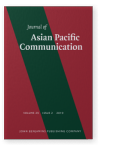Vol. 29:2 (2019) ► pp.230–263
Stereotype formation
An examination of three contesting models in Vietnam
The present study aims (1) to study stereotype contents of a target population, and (2) to test the predictive power of three contesting theoretical models in the communication framework of who→says what→in which channel→to whom→with what effect (Lasswell, 1948). A purposive sample of (N = 291) Vietnamese high school and college students found that they have positive stereotypes about Americans in general and a mix of positive and negative stereotypes about Black/African-Americans. Of the three theoretical models, the communication model had collectively the strongest predictors, followed by the psychological model, and then the contact model. Theoretical as well as practical implications of the study is discussed.
Article outline
- Literature review
- Stereotype contents
- Stereotype process
- Theories that explain stereotype formation
- Communication framework: Direct and indirect contact
- Vietnam
- Vietnamese culture and value system
- Media system in vietnam and Vietnamese’s media use
- Method
- Research design
- Sample
- Measures
- Stereotypes of Americans in general and stereotypes of Black/African-Americans in particular
- Independent variables
- Results
- Descriptive results
- Stereotypes of Americans in general
- Stereotypes of Black/African-Americans
- Testing of three theoretical models
- The Contact Hypothesis model test results
- Psychological model test results
- Communication model test results
- Stereotypes about Americans in general
- Stereotypes about Black/African-Americans
- Comparison of the three theoretical models
- Testing of contesting theoretical models
- Stereotypes about Americans in general
- Stereotypes about Black/African-Americans
- Descriptive results
- Discussion and conclusion
-
References
